Biophysics/Introduction
< BiophysicsBiophysics Projects
| |
Resource type: this resource is a course. |
| |
Subject classification: this is an information technology resource . |
| |
Educational level: this is a tertiary (university) resource. |
| |
Resource type: this resource contains a lecture or lecture notes. |
| |
Action required: please create Category:Biophysics/Lectures and add it to Category:Lectures. |
| |
Subject classification: this is a biology resource . |
| |
Subject classification: this is a physics resource . |
| |
Subject classification: this is a chemistry resource . |
| |
Subject classification: this is a mathematics resource . |
| |
Subject classification: this is a medicine resource. |
| |
Resource type: this resource is an article. |
- Biologie Moléculaire http://fr.wikiversity.org/wiki/Département:Biologie_moléculaire
- Portal:Mathematics
- Portal:Physical Sciences
| |
Physics portal |
| |
Mathematics portal |
| |
Molecular Biology portal |
Welcome to the Biophysics Project and the Department of Biophysics!
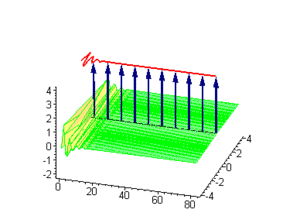
Département de Biophysique
- "Cette discipline aboutit à l'utilisation de moyens modernes d'investigation qualitatifs et quantitatifs en Biologie comme en Médecine, ainsi que, dans cette dernière, à des moyens thérapeutiques à partir de l'utilisation notamment des ondes et radiations."
"La biophysique est l'étude des phénomènes physiques intervenant chez les êtres vivants."
- Faculté de Biologie
Département de Biologie Moléculaire
"La biologie moléculaire est une discipline scientifique au croisement de la génétique, de la biochimie et de la physique, dont l'objet est la compréhension des mécanismes de fonctionnement de la cellule au niveau moléculaire. La biochimie est la discipline scientifique qui étudie les réactions chimiques ayant lieu au sein des cellules."
Languages: (en),(fr), (ro)
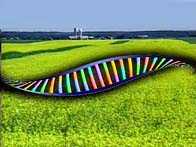
- "Biophysics is the study of physical phenomena that occur in living beings"... , but without a definition of Life, or of the "living", the subject of Biophysics would remain only vaguely pointing at functional organisms. Determining what Life is also remains, therefore, in the domain of Biophysics--specifically of Mathematical biophysics or Relational Biology. In other words, one is asking:
- What are the fundamental relations among the components and processes, and also <relations> among relations occurring in an organism that distinguish the latter from a simple or complex physical system, such as a crystal, a stone, a machine or automaton, a robot, a computer, and so on ?
- A related question is that of the underlying operational logics of an organism (which is not Boolean, and it is not perhaps even a quantum logic), and of its defining axioms.
|
Welcome!
Hello and Welcome to Wikiversity Biophysics/Introduction! You can contact us with questions at the colloquium or me personally when you need help. Please remember to sign and date your finished comments when participating in discussions. The signature icon To get started, you may
|
Welcome to an International Biophysics Course !
- Lecture notes can be now obtained in: English (en), French (fr) and Romanian (ro), (ISO 691-1) languages.
- New instructors or students may add, however, more languages-- among those already approved by the Wikiversity for such educational and research web site projects.
- The addition to this website of specialized expert new lectures or lecture notes or web links to Lecture notes and other Biophysics or Crystallography departments-- that fit in with the announced Syllabus-- is encouraged and appreciated.
- For questions regarding Ph.D. review questions in Crystallography see also Doctoral review questions in Crystallography
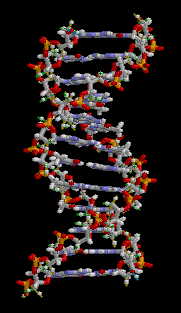 DNA Double-helix Molecular Model
DNA Double-helix Molecular Model
Syllabus
- Protein and Nucleic Acid Structure and Dynamics:
Up-to-date descriptions of the background, methods and techniques of protein crystallography, including the mathematical concepts and tools needed to understand X-ray and neutron diffraction, as well as 2D-FT NMR determination of molecular structure in solution. (See also a simple introduction to Proton (H-1) NMR (fr))
- Protein crystallography is a multidisciplinary area of research that overlaps in part with several subfields of biochemistry, structural molecular biology, bioinformatics, biophysics, biochemistry and organic chemistry.

- Introduction to group theory
- Materials Science and Engineering/List of Topics--Lecture 14:Introduction to the Solid State: The Seven Crystal Systems;The Fourteen Bravais Lattices
Lecture 15:Examples of crystal lattices: fcc, bcc, diamond; Miller indices of crystal lattice planes.
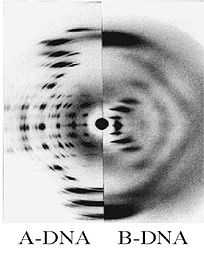
- Fluorescence correlation spectroscopy (FCS) and confocal imaging microscopy of cellular processes and structures.
- Single molecule detection (SMD) and enzyme kinetics.
- Microscopy of Cell Structure, Dynamics and Physiological Function.
- Mathematical Foundations of Biophysics:
- Computational biophysics: Molecular Dynamics and computer simulation techniques (e.g., Monte Carlo)
- Mathematical Foundations of Quantum Biophysics and Quantum Biochemistry
- Harmonic analysis in Medical Diagnostic Imaging and Patient image processing, contrast enhancement or reconstruction
- Modelling cells and multicellular organisms
- Biotopology and Algebraic Topology applications to Mathematical Biophysics
- Relational Networks and Categories of Metabolic-Replication Systems
- Relational Biology applications to understanding Aging and Metabolic Disorders
  The Lessons in the Photosynthetic Mechanisms ORIENTATION |
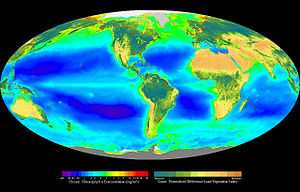 Photosynthesis in the Biosphere
Photosynthesis in the Biosphere
- Syllabus of an International Course on Photosynthesis

- Structure and Dynamics of Photosynthetic Membranes
- Quantum mechanisms of photosynthetic water oxidation in algae and higher plants
- Mechanisms of PS I photosystem
- Manganese and calcium ion role(s) in photosynthetic water oxidation
- The Oxygen Evolving Complex: Structure and Function
- FCS applications to Photosynthesis
- Single Molecule Detection and Femtosecond Laser Spectroscopy studies of Photosynthesis
- High-field and 2D-NMR investigations of Photosynthetic Mechanisms
- FT-NIR Spectroscopy and Hyper-spectral/Chemical Imaging of Photosynthetic Cells and Functional Chloroplasts
Learning materials and introductory articles
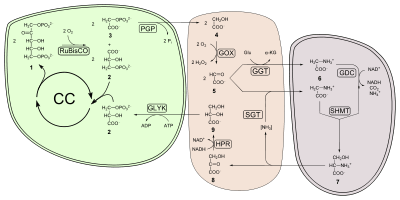
- w:C4 carbon fixation: trace experiments with radioactive labels
- Quantum physics aspects of w:Photosynthesis
- Photosynthetic systems: w:PSI and w:PSII coupling
- w:aquaporin
- Specific w:chloride channels
- w:Hydronium ion
- Specific w:Hydronium ion
- Beta counting
- Specific inhibitors of photosynthesis, such as hydroxylamine (NH2OH) and uncouplers
- Gas chromatography and mass spectrometry
- Gamma counting
- w:Enzyme assays
- w:Micronutrients
- Manganese ions' role(s) in photosynthesis
- Neutron activation analysis of Mn contents in purified, active thylakoid (photosynthetic) membranes and PSII-particles
- Manganese ions' role(s) in photosynthesis
- w:Enzymes
- Krebs' cycle
- w:Pyruvate decarboxylation
- The ATP cycle and its coupling to photosynthetic processes
- w:Oxidative phosphorilation
- w:Calvin Cycle
- Dickens-Horecker cycle
- Hexose interconversions
- w:Neoglucogenesis
- w:Glycogenesis
- w:Glycogenolysis
- w:Cori cycle
- w:fatty acids
- Essential fatty acids
- poly-unsaturated fatty acids (w:PUFA);
- w:eicosanoids: w:prostaglandins, w:thromboxanes, w:prostacyclin and w:leukotrienes.
- The w:lipid bilayer, item, and transport across the bilayer through pores, channels, etc.
- w:PCR
Selected Examples
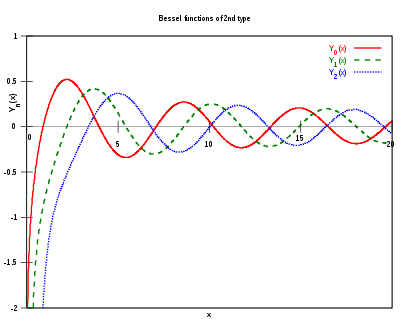
- Bessel functions arise in many mathematical models such as those for vibrating surfaces. Such functions also occur in the analysis of X-ray Diffraction patterns of helical molecules such as certain proteins and also nucleic acids (DNAs, RNAs.)
"When mathematically analyzing a vibrating drum the boundary conditions lead to solutions that are harmonic functions. When using cylindrical coordinates, the solutions are sines, cosines or Bessel functions (in the radial direction)".
Notes
- Medical biophysics is an important area of biophysics applications.
- Presentation = Présentation sur Protéines
"Protéine, macromolécule composée d'acides aminés reliés par des liaisons peptidiques, présente chez les organismes vivants et essentielle à leur fonctionnement. Découvertes en 1838, les protéines sont le principal composant des cellules, représentant plus de 50 p. 100 de leur poids sec. Le mot protéine vient du grec proteios qui signifie « premier ».
La forme des protéines est très variable : elle va des longues fibres présentes dans les tissus conjonctifs et les cheveux aux globules compacts et solubles capables de traverser la membrane des cellules. Les protéines sont des macromolécules dont le poids moléculaire varie de quelques milliers à plus d'un million d'unités. Elles sont spécifiques à chaque espèce vivante et à chaque organe. On estime qu'il existe environ trente mille protéines différentes chez l'Homme, dont 2 p. 100 seulement ont été décrites. Les protéines servent à construire et à entretenir les cellules, et leur dégradation chimique fournit de l'énergie, produisant près de 4 kilocalories par gramme (voir Métabolisme).
Outre leur rôle dans la croissance et l'entretien des cellules, les protéines sont également responsables de la contraction des muscles. Les enzymes digestives sont des protéines, de même que l'insuline et la plupart des autres hormones, ainsi que les anticorps du système immunitaire et l'hémoglobine. Les chromosomes, qui transmettent toutes les caractéristiques héréditaires sous forme de gènes, sont constitués d'acides nucléiques et de protéines (histones)."
- See also: Continuum Mechanics
Course textbooks
- H.R. Wilson. ``Diffraction of X-rays by Proteins, Nucleic acids and Viruses'' London: Arnold publs. (1966).
- Lehninger. "Biochemistry", latest edition.
- D.W. Ball. "Physical Chemistry". (2003).
- Voet & Voet. "Biochemistry". J.Wiley:Oxford, U.K.(2000).
- Advanced DNA Techniques
- Molecular Modelling and Dynamics
- Spectroscopy and Imaging: Principles, Theory, Techniques and Applications
Things remaining to do-Short list
- Continue and expand lectures
- New Instructor involvement in biophysics courses
- Web links to biophysics and protein structure syllabi at several universities
- Add other resources (such as: Structure and Genomic Databases, Image libraries and galleries, Library links, and so on.
- Develop student Enrollment and student Help pages
See also
- Colloquium
- PPS2--Protein Crystallography International Web Course--Birkbeck College, University of London: Principles of Protein Structure--World-wide participation from over 250 students and consultants in 27 countries]
- Mathematical biophysics
- Topic:Mathematical biophysics
- Mathematical biophysics (including computer modelling)
- Topic:Mathematical biophysics
- Membrane biophysics
- ==Lectures (en), (fr),(ro)==
- Lecture 1. Axioms and Logic in Mathematical Biophysics (2011)
- Protéine Leçon 1ere
- Lecture 2. Complex Systems Biology
- Lecture 4. Quantum Topology and Quantum Computing, (2012)
- Lecture 5. Novel Techniques for Microspectroscopy and Chemical Imaging Analysis of Cells and Embryos
- Lecture 6. Electron Microscopy of Cellular Structures (2011).
- Lecture 7. X-ray microscope. (2011)
- Lecture 8. Molecular Imaging of Atherosclerotic Plaques (2010).
- Lecture 9. Electron Paramagnetic Resonance Applications in Biophysics (2012)
- Lecture 10. Selected Mathematics Applications in Physics, Chemistry and Life Sciences.
- Microspéctroscopie et Analyse Biochimique des Images d'Embryon
Leçons par thèmes = Lectures by subject
- Données de physique utilisées en biologie [Modifier]
Leçons par niveau = Lectures by level
- Novice Niveau 0 à 2 Débutant Niveau 2 à 5 Intermédiaire Niveau 6 à 9
- Avancé Niveau 10 à 12
- Données de physique utilisées en biologie
- Expert Niveau 13 à 15
- Ondes et optique géométrique
- Perfectionnement Niveau 16 à 18
- Modèle:2--Microspéctroscopie et Analyse Biochimique des Images d'Embryon. Modifier!
Instructors
If you have knowledge in this field, please post your name here to answer questions from students.
Short list of course consultants and instructors:
- User:Bci21- Instructor & Professor-Professeur
- Biophysik
- Y
- Z
External links for the International Biophysics Course
- Wikipedia biophysics article
- Biophysical Society
- Biophysical Journal
- British Biophysical Society
- Society for Mathematical Biology
- Relational Biology
- [http://www.biophysics.org/2012china/Home/tabid/2984/Default.aspx
- Weak Protein-Ligand Interactions:
- NMR Spectroscopy,Mass Spectroscopy,
- X-Ray Crystallography, Small Angle Light Scattering,
- In Vivo Fluorescence Resonance Energy Transfer(FRET),Single Molecule Fluorescence Spectroscopy,
- Atomic Force Microscopy]
- Basics
- Biomolecules -- Structures, classification and properties of:
- Laboratory and Analytical Methods
- Simple (glass) laboratory equipment and how to use it
- Laboratory safety
- w:Size exclusion chromatography
- UV-VIS Spectrometry
- Centrifugation and w:Ultracentrifugation
- w:Electrophoresis
- w:Chromatography
- Amino acids
- w:Decarboxylation
- w:Transamination
- General amino acid synthesis
- General amino acid catabolism
- Special amino acid metabolism
- Amino acid interconversion
- w:Urea cycle, item
- Gamma-glutamyl cycle
- Associated: w:Gout,w:Maple syrup disease
- Proteins
- In vivo nucleic acids synthesis
- Nucleic acid degradation, pyrimidine and purine catabolism
- w:Peptide bond
- In vivo protein synthesis
References
- S.H. Strogatz, Nonlinear dynamics and Chaos: Applications to Physics, Biology, Chemistry, and Engineering. Perseus, 2001, ISBN 0-7382-0453-6
- N.G. van Kampen, Stochastic Processes in Physics and Chemistry, North Holland., 3rd ed. 2001, ISBN 0-444-89349-0
- L.A. Segel, Modeling dynamic phenomena in molecular and cellular biology. C.U.P., 1984. ISBN 0-521-27477-X
- von Bertalanffy, Ludwig (28 March 1976) [1968]. General System theory: Foundations, Development, Applications. George Braziller. pp. 295. ISBN 978-0-8076-0453-3.
- Hodgkin, Alan L; Huxley, Andrew F (28 August 1952)."A quantitative description of membrane current and its application to conduction and excitation in nerve". Journal of Physiology 117 (4): 500–544. PMC 1392413. PMID 12991237. Retrieved 15 June 2011.
- Noble, Denis (5 November 1960). "Cardiac action and pacemaker potentials based on the Hodgkin-Huxley equations". Nature 188 (4749): 495–497. Bibcode 1960Natur.188..495N. DOI:10.1038/188495b0. PMID 13729365.
- Bu Z, Callaway DJ (2011). "Proteins Move! Protein dynamics and long-range allostery in cell signaling". Advances in Protein Chemistry and Structural Biology. Advances in Protein Chemistry and Structural Biology 83: 163–221. DOI:10.1016/B978-0-12-381262-9.00005-7. ISBN 978-0-12-381262-9. PMID 21570668.
Virtual Labs
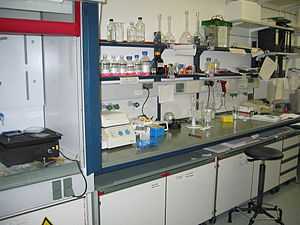
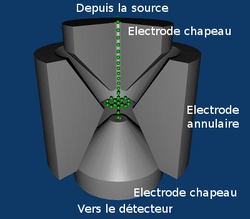
(Schéma d'un analyseur de type trappe ionique (pièges à ions) 3D et trajectoire des ions, en spectrométrie de mass).
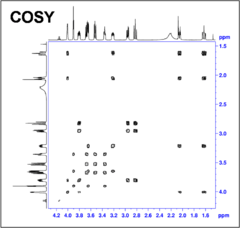
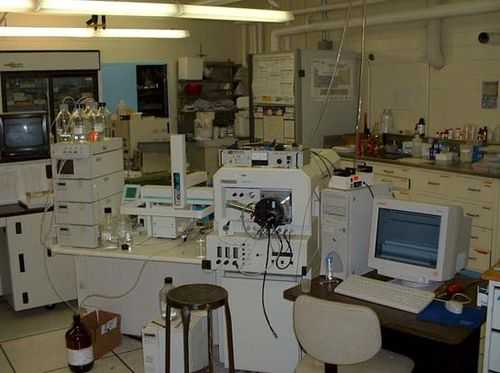
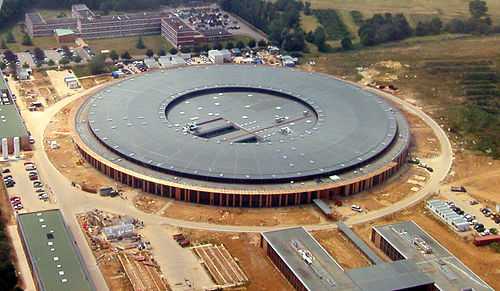
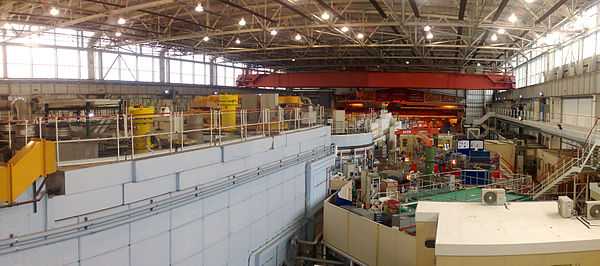
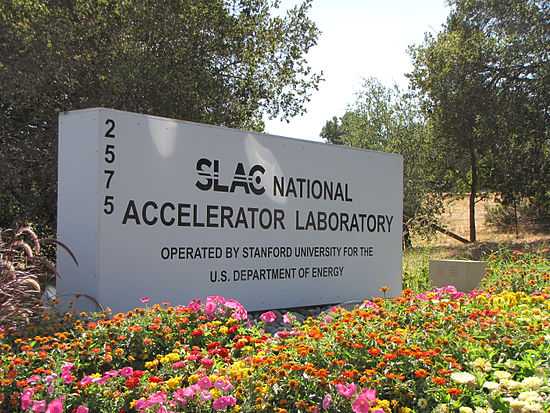
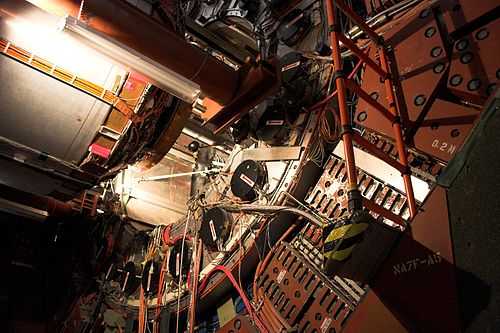
Wikiversity is a centre for the creation and use of free learning materials and activities. Its primary priorities and goals are to:
- Create and host a range of free-content, multilingual learning materials/resources, for all age groups and learner levels
- Host learning and research projects and communities around existing and new materials
- Biophysics. (2012, June 5). Wikiversity, . Retrieved 18:44, June 5, 2012 from http://en.wikiversity.org/w/index.php?title=Biophysics&oldid=918460.
